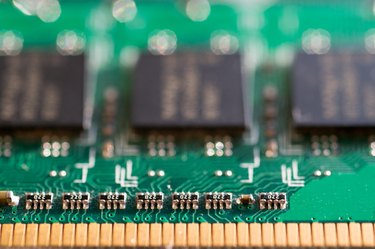
If you know what computer memory is, then you already know what a primary storage device is – the latter term is a lot fancier, but they mean the exact same thing. And no, "memory" is not the massive external hard drive you use to store your out-of-control collection of the finest cat GIFs in the world.
While a central processing unit (or CPU) performs the brainy functions of a computer, carrying out calculations and delegating tasks, memory helps out with those delegations by holding bits of data temporarily to keep the programs you have open up and running. Primary storage devices come in a few different forms, so strap in and put your memory cap on.
Video of the Day
Video of the Day
Primary Storage Devices
When it comes to examples of primary memory, random access memory (or RAM) is probably the most commonplace. RAM is computer hardware, usually in the form of memory modules like DRAM, from which data can be temporarily stored and retrieved. While a disc or hard drive accesses data in a specific sequence, RAM – as the name implies – is able to access it at random, making it a fast and efficient form of primary memory.
Another primary memory example is cache. Cache, or CPU memory, serves as a high-speed memory access area reserved on your computer's main memory or storage device. Cache is actually a part of high-speed static RAM (SRAM), which requires a constant power source to keep its high-speed memory distribution going.
How Does RAM Work?
As soon as you boot your computer on, the CPU allocates parts of the computer's operating system to the primary memory, which allows the CPU to work faster and boot up your PC more quickly. This little microcosm is a pretty good example of how RAM and primary memory works in a nutshell: once the computer is up and running, the CPU continues to hand off various tasks to the memory temporarily until you shut it off. Ideally, you're not aware of the process but it's largely what keeps your computer running smoothly and why high RAM amounts are so prominently advertised.
That means that when your computer is running slow or visibly struggling, there's a good chance it doesn't have enough memory to tackle all the tasks you're throwing at it. So close a few programs and trying shutting down at least most of those 32 browser tabs you have open.
Secondary Storage
Remember that hard drive with the cat GIFs? Yeah, that's a type of secondary storage. Secondary storage hard drives, which store data for the long-term (while primary storage stores it for the short-term) include internal and external types. Smaller hard drives even include USB thumb drives or your smart phone when you hook it up to your computer for the express purpose of viewing or transferring files.
Optical media is another type of secondary storage. Though many modern computers lack optical disk drives, good old CDs and DVDs containing data are also secondary storage devices (technically, so are 3.5-inch floppy disks if you want to go really old-school, but we'll spare you that deep, deep dive for the moment).